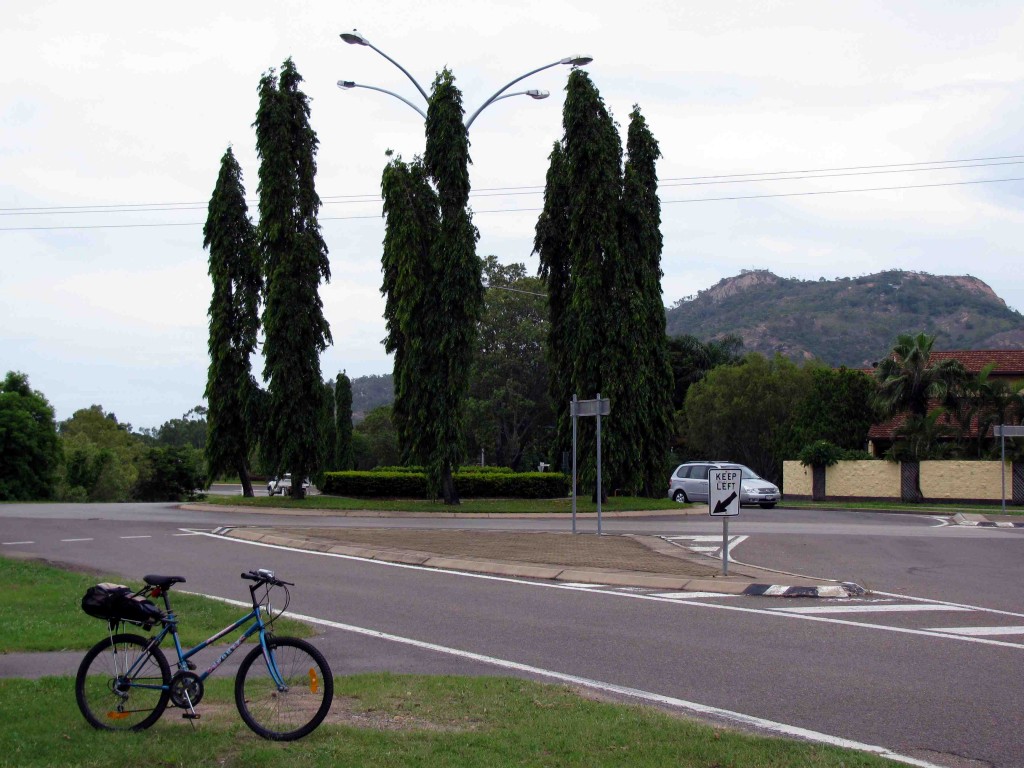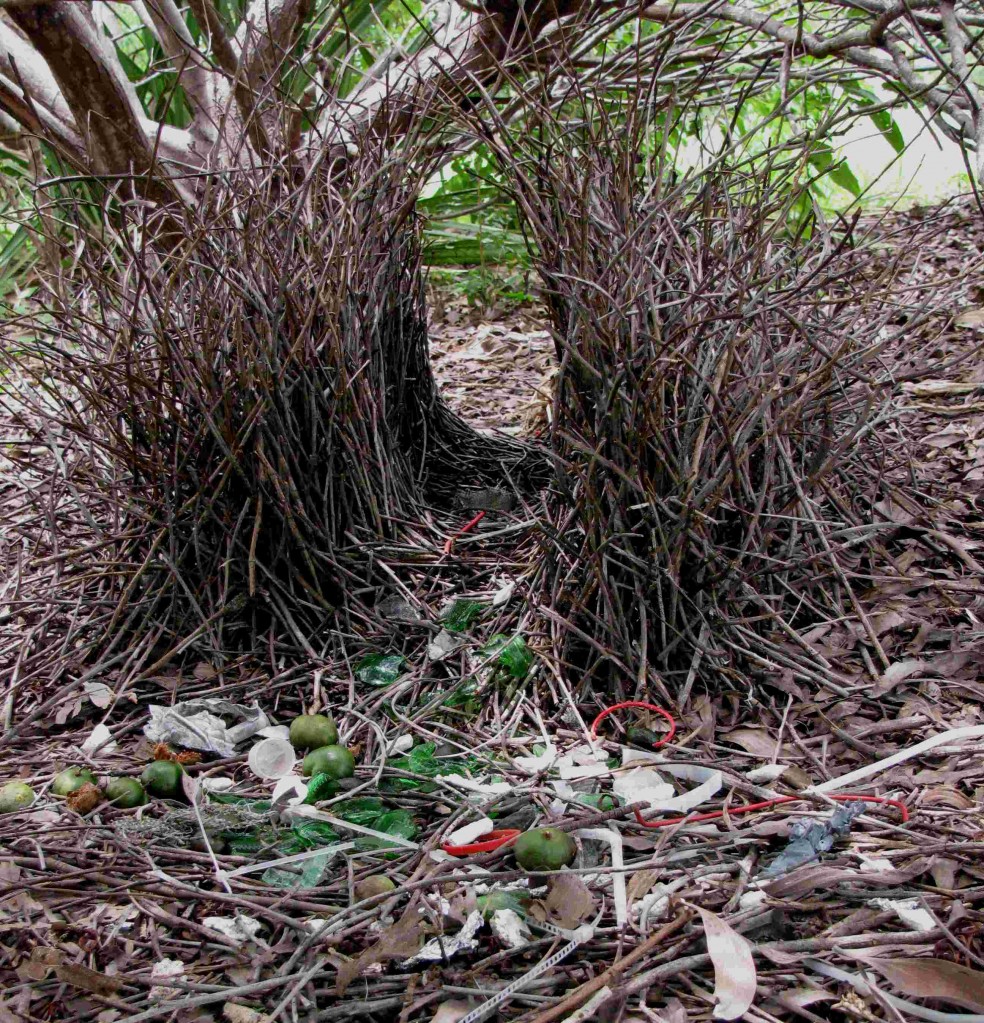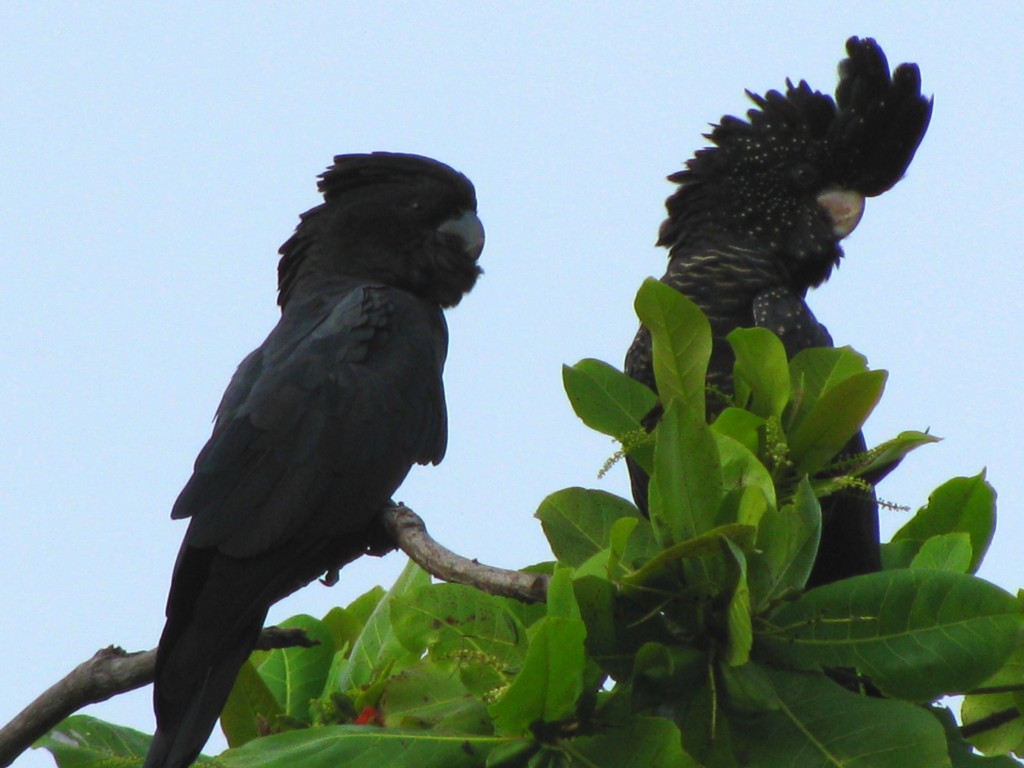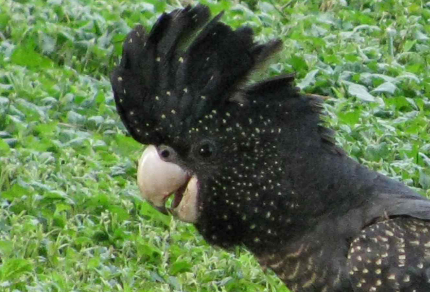
‘Wise Men’ Roundabout, with Castle Hill in background (© Magi Nams)
This morning was a rare cloudy one in Townsville, and I was invaded by a restlessness that made it impossible to sit still and write. Instead, I cycled to old haunts near Richard’s house in the suburb of Railway Estate, pausing to photograph birds and the parkway, as though today I would capture images of Australia in pictures rather than words. I remembered the bower I had found a month ago and sought it out. Scrabbling on my hands and knees among fallen leaves and branches, I crouched close to the ground to photograph it while its owner screeched and hissed at me from a few feet away within a screen of vegetation. If I had been another male bowerbird come to pilfer his decorations or trash the bower, the male would have attacked me, but I think my size intimidated him into settling for verbal abuse and fluttering harassment.

Great Bowerbird Bower (© Magi Nams)
Later, before supper, I slapped and shook off mosquitoes while snapping images of a female red-tailed black-cockatoo near the edge of the golf course lawn. Her black plumage was speckled and scalloped with pale yellow, and her long tail barred with orange. Her classic parrot beak was whitish-grey, and her sparkling eyes a shiny black. She took long, deliberate steps through the grass, stretching her feet wide and displaying their two toes directed forward and two toes directed backward. This, as Vilis and I have seen while watching black-cockatoos feed at The Strand, is an excellent arrangement for holding seeds and fruits, as well as for grasping branches while scrambling about in trees.

Female Red-tailed Black-cockatoo (© Magi Nams)
Strictly speaking, there are two families of birds that are loosely called parrots. The first, the Cacatuidae, includes cockatoos like the red-tailed black-cockatoos and sulphur crested cockatoos we’ve seen around Townsville, plus corellas like the nagging, white little corellas always hanging around the golf course, and the cockatiel, a slim grey and white parrot with a yellow crest which Vilis and I haven’t yet seen.1
The second, larger family is called the Psittacidae and includes the lorikeets, which are very visibly represented in Townsville by the saucy rainbow lorikeets, as well as the rosellas, which are broadtailed parrots like the pale-headed rosellas I saw on the JCU campus, plus a number of other parrot groups whose members I haven’t yet seen but certainly hope to – the typical parrots, fig-parrots, long-tailed parrots, ring-necks, red-capped parrots, blue bonnets, swift parrots, budgies, ground and night parrots, and a few other miscellaneous but very beautiful species.1
The world has a total of 346 species of parrots, and Australia is home to 54 of them.1 The cockatoo-corella-cockatiel family are typically large parrots with simply-coloured plumages. They feed on various nuts, seeds, berries, and fruits and blossoms, and have very powerful articulated (jointed) beaks that they (like the black-cockatoo we watched feeding on Javan almonds) use to tear open seeds and wood, or to dig.1
The lorikeet-parrot-rosella-and-other family are parrots that vary in size from tiny to large and are usually brilliantly coloured.1 They feed on fruits and seeds, grain, insects, and nectar and pollen. Rainbow lorikeets, like all lorikeets, possess brush-tipped tongues that they use to gather nectar and pollen1 from the flowers of eucalypts, paperbarks, and other flowering trees and shrubs. The pale-headed rosellas I saw at JCU used their heavy beaks to tear off grass and herbs.
Some of Australia’s parrots are sedentary, remaining in one area all year long, while others migrate between seasonal food sources.1,2 Some species are nomadic, following the rain, and some, like the budgerigar or budgie, experience population explosions after particularly big Wets followed by abundant growth of grass seeds.1 At least four of Australia’s parrot species are endangered, one is probably extinct due to habitat destruction, and others are rare.2 Many, however, are common,2 which greatly increases the enjoyment of birdwatchers. All the above intriguing parrot facts, I gleaned from Graham Pizzey and Frank Knight’s The Field Guide to the Birds of Australia, which weighs at least a kilogram and is worth every gram of it.

Male and Female Red-tailed Black-cockatoos (© Magi Nams)
Reference:
1. Graham Pizzey and Frank Knight. The Field Guide to the Birds of Australia. 1997. Angus & Robertson, Sydney, p. 532; 2. Ibid, pp. 258-290.


